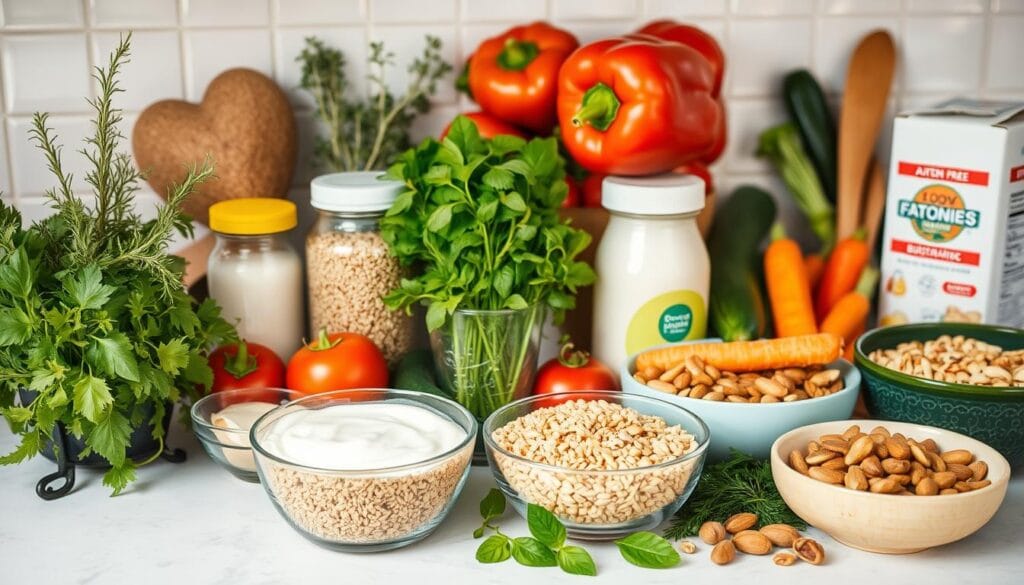Living with Irritable Bowel Syndrome (IBS) can be tough. But, the low fodmap recipes offer hope. Up to 76% of people with IBS find relief in these special meals.
Finding the right food can be hard, even more so with gut health issues. These FODMAP diet recipes aim to ease your symptoms. They let you enjoy tasty, satisfying meals that are good for your gut.
Key Takeaways
- FODMAP diet recipes can dramatically improve IBS symptoms
- Carefully selected ingredients are crucial for gut health
- Meal planning is key to successful FODMAP diet management
- Variety is possible even with dietary restrictions
- Proper nutrition remains essential during the elimination phase
Understanding the FODMAP Diet and Its Benefits
Dealing with digestive health can be tough, like for those with irritable bowel recipes. The low FODMAP diet is a science-backed way to tackle gut problems. It focuses on foods that can upset your stomach.
Monash University in Melbourne, Australia, came up with this diet. It has changed how people handle their digestive symptoms. Nearly 50% of individuals with IBS see big symptom improvements by changing what they eat.
Decoding FODMAPs: The Science Behind Gut Discomfort
FODMAPs are hard-to-digest carbs that can upset your stomach. They include:
- Fermentable oligosaccharides
- Disaccharides
- Monosaccharides
- Polyols
These carbs aren’t well absorbed in the small intestine. This leads to gas and can cause stomach pain if you eat too much of them.
The Three-Phase FODMAP Approach
| Phase | Duration | Key Action |
|---|---|---|
| Elimination | 2-6 weeks | Remove high FODMAP foods |
| Reintroduction | 6-8 weeks | Systematically test food triggers |
| Maintenance | Ongoing | Personalized diet management |
Key Benefits for Digestive Wellness
Using low FODMAP recipes can really help with digestive problems. Up to 86% of people say they feel better. It’s a good way to manage irritable bowel recipes.
“The low FODMAP diet is not a lifetime diet, but a short-term strategy to identify your specific food triggers.” – Monash University Researchers
Even though it works for many, it’s smart to talk to a healthcare pro. They can make sure you’re doing it right and meeting your nutritional needs.
Essential Low FODMAP Ingredients for Your Kitchen

Having the right ingredients in your kitchen is key for making low FODMAP recipes. Knowing which foods are good for your digestive health can change how you plan meals. It makes cooking for a fodmap diet easier and less stressful.
Your low FODMAP pantry should have a variety of ingredients that are easy on your stomach. Here are some important food groups to think about:
- Proteins: Chicken, beef, eggs, fish, and tofu (in moderation)
- Fruits: Strawberries, kiwi, oranges, grapefruit, and cantaloupe
- Vegetables: Carrots, spinach, bell peppers, cucumber, and potatoes
- Grains: Rice, quinoa, corn, and gluten-free oats
- Nuts and Seeds: Macadamia nuts, pumpkin seeds, and almonds
When you go shopping for low FODMAP ingredients, choose fresh, whole foods. The Monash University App is a great tool for checking food sizes and FODMAP levels.
“Your diet is a bank account. Good food choices are good investments.” – Bethenny Frankel
About 75% of people with irritable bowel syndrome find relief with low FODMAP foods. By stocking your kitchen with these foods, you’ll be ready to make tasty and comforting meals.
Fodmap Diet Recipes for Every Meal
Managing digestive health through diet can be tough, mainly for those with IBS. Finding tasty low FODMAP dinners and IBS friendly meals makes sticking to a diet easier.

Creating meals that are good for your gut doesn’t mean they can’t be tasty. The trick is knowing which foods are best for your digestive system.
Quick and Nutritious Breakfast Options
Begin your day with energizing, gut-friendly breakfasts:
- Lactose-free yogurt with sliced strawberries
- Gluten-free toast with scrambled eggs
- Quinoa porridge with almond milk
Satisfying Lunch and Dinner Solutions
Low FODMAP dinners can be both tasty and healthy. Here are some IBS friendly meals:
- Grilled chicken with roasted bell peppers
- Salmon with zucchini noodles
- Quinoa bowl with grilled tofu
“Eating well with IBS is about smart ingredient choices, not limitation.”
Healthy Snacks and Desserts
Keep your diet goals with these tasty, gut-friendly snacks and desserts:
- Rice cakes with almond butter
- Lactose-free coconut milk ice cream
- Carrot sticks with herb-infused olive oil dip
Remember, everyone’s digestive system is unique. Always talk to a healthcare professional to tailor your low FODMAP diet.
Tips for Success with FODMAP Meal Planning
Starting with fodmap diet recipes can seem tough. But, with the right steps, you’ll get the hang of it. Planning your meals well is crucial for a successful low FODMAP diet.
First, learn what you need for your diet. Studies show that 75% of IBS patients feel better with the right food choices.
“Preparation is the secret ingredient to dietary success” – FODMAP Nutrition Experts
Essential Meal Planning Strategies
- Create a weekly meal template
- Stock your pantry with low FODMAP staples
- Prep ingredients in advance
- Use trusted recipe resources
Here are some useful tips for meal planning:
- Check what you already have
- Choose recipes that are good for your gut
- Make a detailed shopping list
- Batch cook when you can
The FODMAP Friendly app is a great help. It has over 200 low FODMAP recipes and lets you customize them. This app can really boost your confidence and knowledge.
| Planning Stage | Duration | Key Actions |
|---|---|---|
| Elimination Phase | 2-6 weeks | Remove high FODMAP foods |
| Reintroduction Phase | 8 weeks | Gradually test food tolerances |
Keep in mind, everyone is different. Talking to a FODMAP-trained dietitian can really help. They can give you advice that’s just right for you.
Conclusion
Starting a low FODMAP diet can change how you manage IBS symptoms. These meals are not just for relief. They help you understand what your body needs.
Exploring these recipes and strategies can open up a world of tasty options. These options support your digestive health.
Your experience with low FODMAP recipes will be unique. Everyone reacts differently to certain foods. The elimination and reintroduction phases are very important.
Being patient and careful is key. It helps you find out what foods trigger your symptoms. This way, you can make a diet plan that really works for you.
The world of gut health is complex, but you can take charge. Low FODMAP recipes are about more than just avoiding foods. They’re about feeling your best and being empowered through nutrition.
Start your journey today. Choose a diet that supports your health and well-being.
Being committed to these dietary strategies can greatly improve your life. Trust the process and listen to your body. Enjoy the delicious IBS friendly meals that nourish your gut and spirit.
FAQ
What exactly are FODMAPs?
How long does the FODMAP elimination diet typically last?
Can I eat out while following a low FODMAP diet?
Are all fruits and vegetables off-limits on a low FODMAP diet?
How do I know if the FODMAP diet is working for me?
Is the low FODMAP diet a permanent solution?
Do I need to see a doctor or dietitian before starting the FODMAP diet?
Source Links
- Low FODMAP Recipes: Delicious and Digestive-Friendly Options for a Happy Gut – https://betterme.world/articles/low-fodmap-recipes/
- The ultimate low FODMAP foods list: what to eat and what to avoid – Oshi Health – https://oshihealth.com/low-fodmap-foods-list/
- Low FODMAP diet: Foods, benefits, and how it works – https://www.medicalnewstoday.com/articles/319722
- FODMAPs and the FODMAP Diet Explained – https://zoe.com/learn/what-are-fodmaps-and-the-fodmap-diet
- The Ultimate Low FODMAP Shopping List (+Printable!) – https://www.bayskitchen.com/blogs/ibs-diet/low-fodmap-shopping-list?srsltid=AfmBOoqoS2qCX509z4e3v0uR4GKZVgsDGCkRDgRRDRSqWjSjLR2gJbck
- Easy low FODMAP dinners — Noisy Guts – https://www.noisyguts.com/blog/mix-n-match-for-easy-low-fodmap-dinners
- How To Make Low FODMAP Seasoning Blends & Spice Mixes – FODMAP Everyday – https://www.fodmapeveryday.com/how-to-make-low-fodmap-seasoning-blends/
- Creating a Low FODMAP Meal Plan: Tips, Recipe Ideas, and More – https://www.healthline.com/nutrition/low-fodmap-meal-plan
- Low-FODMAP Recipe Ideas To Start Your Year Off Right – https://www.delish.com/cooking/recipe-ideas/g63363068/low-fodmap-diet-recipes/
- 7 Day Low FODMAP Meal Plan Ideas: Recipes & Prep – https://www.verywellfit.com/7-day-low-fodmap-meal-plan-ideas-recipes-and-prep-6746970
- Top tips for starting the low FODMAP diet – https://fodmapfriendly.com/blogpost/starting-the-low-fodmap-diet/
- What Is a Low-FODMAP Diet – https://www.webmd.com/ibs/what-is-fodmap
- Low FODMAP and Anti-Inflammatory Diet – Health Loft – https://healthloftco.com/low-fodmap-and-anti-inflammatory-diet/
- A Dietitian’s guide to low FODMAP cantaloupe | recipes included – THE IBS DIETITIAN – https://theibsdietitian.com/blog/a-dietitians-guide-to-low-fodmap-cantaloupe-recipes-included
- Low FODMAP Mediterranean Diet: A Guide for IBS Sufferers — Music City Nutrition & Wellness – https://www.musiccitynutritionandwellness.com/nutrition-and-wellness-blog/low-fodmap-mediterranean-diet-a-guide-for-ibs-sufferers

I’m extremely impressed along with your writing skills and also with the layout in your blog.
Is that this a paid subject or did you modify it your self?
Either way stay up the excellent high quality writing, it’s
rare to look a nice blog like this one today.
Youtube Algorithm!
Your point of view caught my eye and was very interesting. Thanks. I have a question for you.
Can you be more specific about the content of your article? After reading it, I still have some doubts. Hope you can help me.